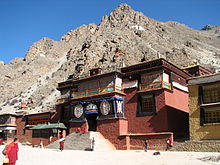
The Karmapa Tulku lineage of the Gyalwa Karmapa is the oldest among the major incarnating lineages of Tibetan Buddhism, established in 1110 CE by the 1st Karmapa, Düsum Khyenpa. Karmapa means “the one who carries out buddha-activity”, or “the embodiment of all the activities of the buddhas.” A total of 17 Karmapa manifestations have incarnated after their predecessors predict their own rebirths in detailed letters.

Rumtek Monastery, also called the Dharma Chakra Centre, is a gompa located in the Indian state of Sikkim near the capital Gangtok. It is the seat in exile of the Gyalwang Karmapa, inaugurated in 1966 by the 16th Karmapa. It is also a focal point for the sectarian tensions within the Karma Kagyu school of Tibetan Buddhism that characterize the 17th Karmapa controversy.
There are currently two, separately enthroned 17th Gyalwang Karmapas: Ogyen Trinley Dorje and Trinley Thaye Dorje. The Karmapa is the spiritual leader of the nine-hundred-year-old Karma Kagyu lineage of the Kagyu school of Tibetan Buddhism.
Tai Situpa is one of the oldest lineages of tulkus in the Kagyu school of Tibetan Buddhism In Tibetan Buddhism tradition, Kenting Tai Situpa is considered as emanation of Bodhisattva Maitreya and Guru Padmasambhava and who has been incarnated numerous times as Indian and Tibetan yogis since the time of the historical Buddha.

The 1st Karmapa, Düsum Khyenpa was the 1st Gyalwa Karmapa, head of the Karma Kagyu school of Tibetan Buddhism. His name Düsum Khyenpa means "knower of the three times", the past, present and future. It was given to him to refer to the knowledge of the three forms of time he gained at his enlightenment, including the "timeless time" of enlightened awareness.

Ogyen Trinley Dorje, also written as Urgyen Trinley Dorje is a claimant to the title of 17th Karmapa.

Trinley Thaye Dorje is a claimant to the title of 17th Karmapa.

The 16th Karmapa, Rangjung Rigpe Dorje is the 16th Gyalwa Karmapa and the spiritual leader of the Karma Kagyu lineage of Tibetan Buddhism. He is of the oldest line of reincarnate lamas in Vajrayana Buddhism, known as the Karmapas whose coming was predicted by the Buddha in the Samadhiraja Sutra. The 16th Karmapa was considered to be a "living Buddha" and was deeply involved in the transmission of Tibetan Vajrayana Buddhism to Europe and North America following the Chinese invasion of Tibet. He was known as the "King of the Yogis", and is the subject of numerous books and films.

Jamgön Kongtrül Lodrö Thayé, also known as Jamgön Kongtrül the Great, was a Tibetan Buddhist scholar, poet, artist, physician, tertön and polymath. He is credited as one of the founders of the Rimé movement (non-sectarian), compiling what is known as the "Five Great Treasuries". He achieved great renown as a scholar and writer, especially among the Nyingma and Kagyu lineages and composed over 90 volumes of Buddhist writing, including his magnum opus, The Treasury of Knowledge.
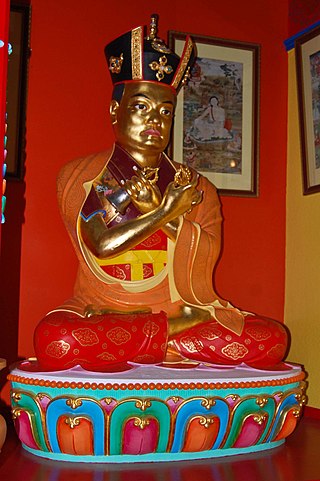
Karma Kagyu, or Kamtsang Kagyu, is a widely practiced and probably the second-largest lineage within the Kagyu school, one of the four major schools of Tibetan Buddhism. The lineage has long-standing monasteries in Tibet, China, Russia, Mongolia, India, Nepal and Bhutan, with current centres in over 60 countries. The spiritual head of the Karma Kagyu is the Gyalwa Karmapa; the 2nd among the 10 Karmapas had been the principal spiritual advisors to successive emperors of China. The Karma Kagyu are sometimes called the "Black Hat" lamas, in reference to the Black Crown worn by the Karmapa.

Mipham Chokyi Lodro, also known as Kunzig Shamar Rinpoche, was the fourteenth Shamarpa of the Karma Kagyu school of Tibetan Buddhism. The Shamarpa is the second-most important teacher of the Karma Kagyu school, after the Karmapa.
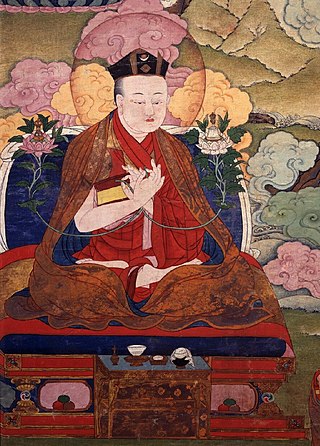
The 3rd Karmapa, Rangjung Dorje (1284–1339) was the 3rd Gyalwa Karmapa and head of the Karma Kagyu school, the largest school within the Kagyu tradition. He was an important figure in the history of Tibetan Buddhism, who helped to spread Buddha-nature teachings in Tibet.
Nenang Pawo is one of the highest lamas of the Karma Kagyu school of Tibetan Buddhism. The Pawos form a lineage of tulkus, of which the first was born in 1440. They were traditionally the heads of Nenang Monastery in Ü-Tsang.
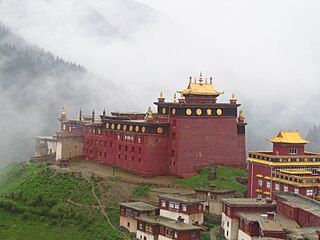
Palpung Monastery is the name of the congregation of monasteries and centers of the Tai Situpa lineage of the Kagyu school of Tibetan Buddhism as well as the name of the Tai Situ's monastic seat in Babang, Kham. Palpung means "glorious union of study and practice". It originated in the 12th century and wielded considerable religious, political, and economic influence over the centuries.

Khenpo Karma Tharchin Rinpoche, widely known by his abbreviated name Khenpo Karthar Rinpoche, was a senior lama of the Karma Kagyu school of Tibetan Buddhism. Before his death he served as abbot of Karma Triyana Dharmachakra (KTD) Monastery in Woodstock, New York.

Pema Dönyö Nyinje is the 12th Tai Situpa, a tulku in Tibetan Buddhism, and one of the leading figures of the Karma Kagyu school. He is the head of Palpung Monastery.
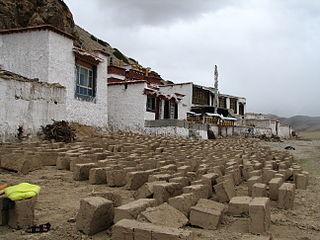
Yangpachen Monastery is a Tibetan Buddhist monastery in Yangpachen, in the Lhasa Prefecture of Tibet. It is historically the seat of the Shamarpas of Karma Kagyü. It is about 85 km (53 mi) southeast of Lhasa "on the northern side of the Lhorong Chu valley above the Lhasa-Shigatse highway."
The name Karma Chagme refers to a 17th-century Tibetan Buddhist (Vajrayāna) lama and to the tülku lineage which he initiated. Including the first, seven Karma Chagme tülkus have been recognized. The Neydo Kagyu sub-school of the Karma Kagyu was established by the first Karma Chagme, Rāga Asya.

Urgyen Tsomo (1897–1961) was a prominent Tibetan Buddhist female master who was known as the Great Dakini of Tsurphu. She was the consort of the Khakyab Dorje, 15th Karmapa Lama. She was considered by other masters to be the reincarnation (emanation) of Yeshe Tsogyal, the consort of Padmasambhava of the 8th century, who spread Buddhism in Tibet.
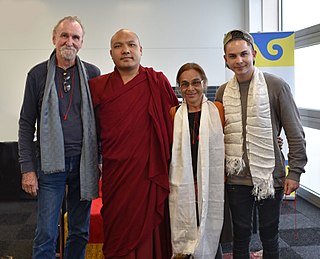
Terris Nguyen Temple, born in Bakersfield, California, May 5, 1944,died on July 8, 2024. studied the art of Tibetan thangka painting in Nepal during the years 1966 to 1975. For the past twenty five years, the Nguyen Temples have been the official artists to Ogyen Trinley Dorje, the 17th Gyalwa Karmapa, and Tsurphu Monastery, Tibet.
